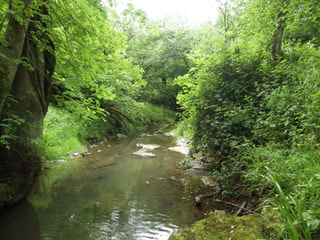Local Resources
Water and Waterways
Local
Local Pure Water Sources:
Chalice Well
Chilkwell Street. Also known as the Red Spring, it is a well situated at the foot of Glastonbury Tor. The natural spring and surrounding gardens are owned and managed by the Chalice Well Trust, founded by Wellesley Tudor Pole in 1959. The Water issues from the spring at a rate of 250,000 imperial gallons (1,100,000 litres) per day and has never failed, even during drought. Iron oxide deposits give the water a reddish hue, as dissolved ferrous oxide becomes oxidized at the surface and is precipitated. The water is reputed to possess healing qualities.
White Spring
Well House Lane. Natural, calcium-rich spring in a Victorian pump house, now a free-entry temple and pilgrimage site. The White Spring itself has a high calcium carbonate content, originating from the limestone that underlies the area.
Glastonbury Spring Water,
Park Corner Farm. Local water bottling company. The water source is from a borehole named George’s Spring. Water now available in glass bottles. Contact: Ian Tucker.
Flood Prevention: Glastonbury’s drains only get routinely cleaned and cleared once every 4 years, but if you see a drain that needs clearing and report it they will respond. This is really important in the autumn when leaves can cause problems and in the light of increasing extreme weather events to prevent our town from getting flooded, one thing we can do is keep an eye out for potential issues. Report blocked drains.
Regional
The Brue Crew
Restoring our local River Brue (mostly concerned with the Bruton area). Contact: Ewan Jones
The River
An exploration of a disconnected river: the Brue and the Axe in Somerset, book by Bruce Garrard.
Co-Adapt
'Working together now to adapt naturally to the climate of the future'.
The focus is on the Somerset Levels and Moors, Porlock Vale and the catchment of the River Culm, which flows down into Devon from its source near Holman Clavel in the Blackdown Hills in Somerset. Initial projects in Wedmore and Langport.
Supported by The Somerset Rivers Authority and other agencies.
2050 Sea Level rise map showing vulnerable areas in UK: one third of Somerset under water.
Holy Wells of Somerset
A rather antiquated list of wells and springs and their folklore.
Many now sadly overgrown and neglected. Important that they are reinstated and quality of water checked.
West Country Rivers Trust
Bringing rivers to life. Inspiring a love of rivers to support people and wildlife.
Other
TED talk: Why Lakes And Rivers Should Have The Same Rights As Humans
Protecting the environment: Water is essential to life, yet in the eyes of the law it remains largely unprotected – leaving many communities without access to safe drinking water, says legal scholar Kelsey Leonard. In this powerful talk, she shows why granting lakes and rivers legal "personhood" – giving them the same legal rights as humans – is the first step to protecting our bodies of water and fundamentally transforming how we value this vital resource.
Universal Declaration of River Rights (draft)
All rivers are living entities that (should!) possess legal standing in a court of law:
All rivers shall possess, at minimum, the following fundamental rights.
(1) The right to flow;
(2) The right to perform essential functions within its ecosystem;
(3) The right to be free from pollution;
(4) The right to feed and be fed by sustainable aquifers;
(5) The right to native biodiversity; and
(6) The right to regeneration and restoration. Click on link to see full document.
Dealing with sewage: reedbed sewage system
